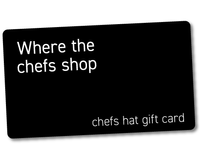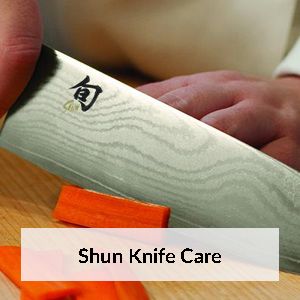- The product was removed from the cart.
Shun Knife Care
One aspect of caring for your knives is maintaining the edge and, when needed, sharpening the blade. But it’s also important to be aware of how you’re using your knives on a daily basis.
Cutting Surface & Cutting Technique
The cutting surface you use makes a big difference in keeping your knives sharp. A good cutting board will help retain a sharp edge for substantially longer. Wood, and polypropylene boards are excellent choices. Tile, ceramic, marble, granite, or any kind of glass cutting boards are poor choices and are very hard on your knives.
Shun Cutlery is designed to be used in a smooth, slicing motion—and never in a forceful, up-and-down “chopping” manner. The proper cutting motion is a "locomotive" motion, pushing the knife forward and down as you cut through the food, then pulling the knife up and back towards you (in order to position it for the next cut). This motion is also similar to cutting wood with a handsaw—forward and down, then back. The razor-sharp blade of your Shun makes this practically effortless.
When you first begin using a Shun, go slowly and enjoy the precision cutting ability of your new kitchen cutlery. As you gain experience, you will be able to work more quickly. No matter what your experience level, be careful and always pay attention to where your fingers are in relation to the knife.
Use your Shuns on meats and vegetables only, not on bones or very thick-skinned vegetables. For heavier kitchen work, try our Classic Meat Cleaver (DM0767). It's designed to handle more aggressive work in the kitchen, such as breaking down chickens and preparing thick-skinned vegetables.
Cleaning and Storage
As with any lifetime investment, it’s important to take the best care possible in order to prolong the life of your knife. Shun recommends that you protect your investment by handwashing your blades with gentle dish soap. Don’t use soaps with citrus extracts or bleach; they can promote corrosion. Rinse and towel dry immediately. Let the knives air dry for a few minutes before returning them to storage. Never leave your knife sitting in a sink full of soapy water. It does metals no good to be submerged in water for prolonged periods of time, and it’s a danger to you when you reach in.
Micro-corrosion, which can result in tiny chips or missing pieces in your knife’s cutting edge, can occur because moisture is left on the cutting edge. Moisture weakens the stainless steel and promotes micro-corrosion. If moisture is left on the cutting edge repeatedly, even normal use in the kitchen can result in small chips in the weakened sections of the edge. To guard against this, wash your knife immediately after use and dry it very thoroughly with an absorbent cloth or towel. Please take extra care to safely dry the sharp cutting edge of your Shun, keeping your fingers away from the edge.
After you have washed and dried your knives, store them in a block, knife case, in-drawer tray, or sheath. We do not recommend storing the knives unsheathed in a drawer, as this can be a potential hazard to the blades as well as your fingers.
Honing and Sharpening
In order to maximize the life of the blade, regular honing with a Shun steel will be necessary. Weekly honing will extend the time between sharpening significantly. When the time comes to sharpen these premium blades, we recommend using a whetstone, or sending the knives to a professional sharpener.
Single-Bevel Blade Care
The Shun Classic Pro Line and a selection of the knives in the Wasabi Black line are single-beveled blades. In addition to the general care above, you can give your single-beveled blade some additional TLC to enhance its razor-like qualities.
Like those of most manufacturers, Shun and Wasabi single-beveled blades have a micro-bevel on the blade back. This enables you to use the blade right out of the box—and to be able to touch up the edge using a smooth hone or 6000-grit whetstone.
However, for chefs who want the most exquisite of single-bevel edges, both Shun Classic Pro and Wasabi Black can be further sharpened and shaped using a method known as uraoshi. The uraoshi process can be done by the knife owner using a series of progressively finer-grit whetstones or by a professional sharpening service.
Uraoshi flattens the back of the blade along the edge and the spine. The slight hollow in the blade back, which helps food release from the blade, remains in the blade's center; only the edges are completely flattened. Since there's no angle to maintain, this makes sharpening easier; you simply pull the blade flat across the whetstone. It reduces sharpening effort, too, since you're only concerned with the edges and not the entire back of the blade. Further, it strengthens the edge.
That said, uraoshi sharpening is a learned skill and Shun recommends having a professional sharpener do this for you unless you are a skilled sharpener yourself. It is not required in order to use your knife, but it is a professional enhancement.
-
Beautiful article. After reading your article, I want to buy this one knife. How beautifully you describe the care of knives. I have the few branded knives, and I do care them. Regularly wash them, not put them at whenever place in the kitchen. I bought the leather knife bag for them to make safe and secure. I bought it from https://tapcibo.com/best-knife-roll-bags/Date: 20-08-2018alysabrough


